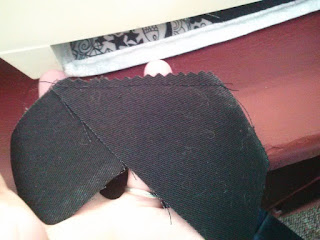Before my son was born, my husband’s uncle passed down a
rocking chair to me. While it was a lovely rocking chair, it was quite
uncomfortable, and I couldn’t exactly imagine rocking a baby to sleep in it. So
I set out to make a cushion for it.
Just before he was born, I then realized that there is no
point in having a nice chair in a nursery if I can’t prop my feet up, too. So I
upcycled a thrift store end table into a nice, cushiony ottoman, which my cats
love to sleep on. As you can see, it’s a lovely set, but something was still
missing.
The
fabric remaining from my two previous projects was calling out to me. Make a
pillow, you know you want to.
So,
here we are. While this will be going in my son’s nursery, it is by no means
for baby... It’s totally, unashamedly, for me. You can use these basic
techniques to make a decorative pillow for any room of the house.
First
things first, you’ll need sufficient materials for your project, and a plan. I
want my finished pillow to be 12”x18”.
I
doodle something like this every time I work on something, even when it’s
simple. It helps keep me organized, and helps me visualize the finished
product.
You
can see that I’ve figured in 1/2” seams. On a typical project, I like to work
with 1/4” seams, but with something that is going to be experiencing a tad more
wear and tear, a larger seam allowance is a good thing.
First
off, cut out all of your fabric. If you’re using a patterned fabric like mine,
it’s important to take the design into account when cutting, like so:
Yes, I’m a rebel.
I use sharpie to mark the lines on my fabric.
[
You’ll
need:
l
Enough material for both the front and back of
your pillow
l
Natural Cotton Piping, the length of the total
perimeter of your pillow, plus a few extra inches. (I’m using 3/8” width, but
you can use whatever size you like)
l
Strips of fabric, about 2” wide, equal to the
length of your piping.
l
Matching thread
l
Stuffing
Now
that we’ve gathered everything we need, take a break to pay attention to your
attention-starved cat.
We’ll
start out by making our piping. Now, you could buy finished piping at
the fabric store. But why would you? Making your own is great, for two reasons.
One, it’s cheaper! I’m all about my projects being more affordable. Two, it
will match your project perfectly.
Unless
you bought several yards of fabric, you probably ended up needing to cut
multiple strips to get the correct length. That’s totally okay! It only takes a
couple of minutes to join them.
Match
the ends of two of your strips together, like so:
And
sew diagonally from the corners of the short ends of your strips:
Trim
off the excess fabric, leaving about a quarter inch. It’s okay if you don’t
have pinking shears, a straight cut will work just as well.
Take
a moment to iron open the seam.
[
See
how the seam is at an angle, instead of straight up and down? This minimizes
the bulk that is created when you are joining multiple layers of fabric. Small
details like this will make your finished project look much more professional.
If
you’re using dark fabric like I am, take a moment to lint roll away any stray
pet hairs or lint.
Now,
take your piping, and lay it in the center of your fabric strip. You can pin
the length, if you like, but I don’t find it to be entirely necessary.
Fold
your fabric over the piping, matching up the edges, and get your sewing machine
ready to sew. As you can see, I’ve switched over my standard presser foot for a
zipper foot:
[
Sew
along the piping, as close as possible. You don’t need to worry about a lock
stitch at either end. Use one hand to feed the piping to the machine. I tend to
lead it in from the opposite side of the foot from the needle, to keep my
stitches as snug to the edge as possible. It should only take you a couple of
minutes to zip along.
Attach
the pieces of the front (and back) of your pillow.
Iron
your seams open and your fabric flat.
Time
to attach our piping! This part is pretty straight-forward. With the right side
of the front of your pillow case facing you, pin your piping to the perimeter.
Try to keep about a half-inch from the edge. You can measure if you want (I
prefer to eye-ball it).
When
you reach the corner, bend your piping to fit:
Pin.
Make a small cut at the corner almost-but-not-quite up to the stitching of your
piping, so that you can spread your fabric flat again. If you were going around
a more rounded corner, you could make several of these cuts to accommodate it.
Continue
pinning around.



























No comments:
Post a Comment